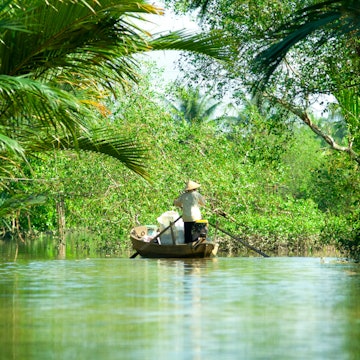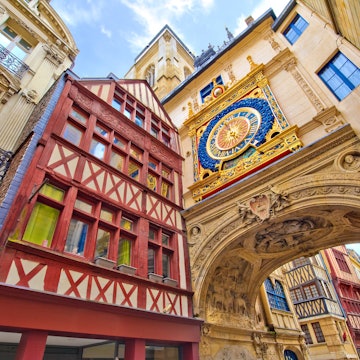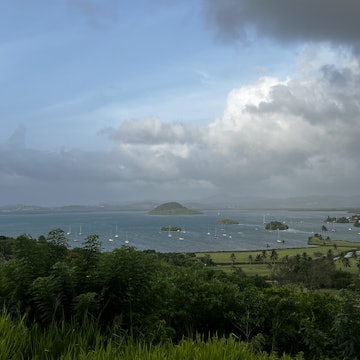

Mont St-Michel. Jean-Philippe Tournut/Getty Images
Normandy: the northwest region of France rolls off an English-speaking tongue as easily as a French one.
It’s known for its bucolic countryside and impossibly long stretches of beach where the famous D-Day landings took place during WWII. Beyond the shores lies much to discover: a rich literary history, four protected designation of origin cheeses, and of course, the iconic Mont St-Michel, a surreal Gothic abbey dating from the 13th century set on top of an island that appears to float like a mystical dream during high tide.
But the floating abbey is just one among many things to do in the region, which can be divided into two main sections. There’s La Normandie Haut, or upper Normandy aka the Parisian’s Normandie, accessible by train and dotted with beachgoers and casino gamblers in Deauville and Trouville. Then there’s La Basse Normandie, or lower Normandy, which is much further from the country’s capital and offers sights and tastes a bit more off the beaten track. Here are the very best things to do, eat and see in Normandy that will leave you wanting to come back for more.
1. Holiday like a Parisian in seaside Deauville
For those with busy schedules who want to carve out a weekend with fresher seaside air, a quick train ride will take you from the bustling French capital to the calmer and more relaxed shores of the Côte Fleurie. One popular destination is the glamorous beachside town of Deauville. There you’ll find locals with sunglasses on and sleeves rolled, strolling in loose linen outfits that perfectly match the white sand beaches dotted with colorful umbrellas. Along the shore, you’ll find Les Planches, 1920s wooden art-deco changing cabins bearing the names of Hollywood stars who’ve attended the town’s yearly fall American film festival.
If proximity to fame makes you hungry, get the perfect meal at L’Etoile Sur Mers, where you can pick out seafood that has been freshly cooked and served (though the uni – or sea urchin – is exceptional raw). Equestrian fans can head to the Deauville-La Touques racecourse, where the fiberglass sand track allows for races even in the winter, or sit on a plush leather chair and test your luck at one of the many spinning bright lights of the slot machines at the Casino Barriere.
Planning tip: If you’re making the trip from Paris, book train tickets in advance online to save on fares.
2. Visit the iconic abbey at Mont St-Michel
It’d be impossible to talk about Normandy without mentioning the iconic Mont St-Michel, a floating abbey known as "the Wonder of the Western World." The sight of it is surreal and unique, but it’s even better when you aren’t fighting for boardwalk space. Get there as early as possible (or late) to avoid crowds, and if you can walk, skip the free shuttle that’s usually packed with tourists and has long lines.
The best way to discover the island is to simply wander into the tiny crevices and narrow alleys. The abbey itself is beautiful, with chimneys as big as some modern living rooms. Trekking around barefoot in the surrounding bay is also quite an experience, and the cool sand relieves worn feet, but due to quicksand and a fast-rising tide, you should only attempt it with a seasoned guide, such as Ludo, who was raised in the area.
Local tip and detour: While the famous local specialty, omelette de la mère Poulard, that tourists usually flock to looks impressive, it’s quite pricey and not good value. Drive instead to the Auberge Sauvage, an incredible modern French restaurant that offers 6- or 8-course meals made with locally grown garden fruits and vegetables – the humble carrots transformed into glazed edible sculptures are nothing short of art.
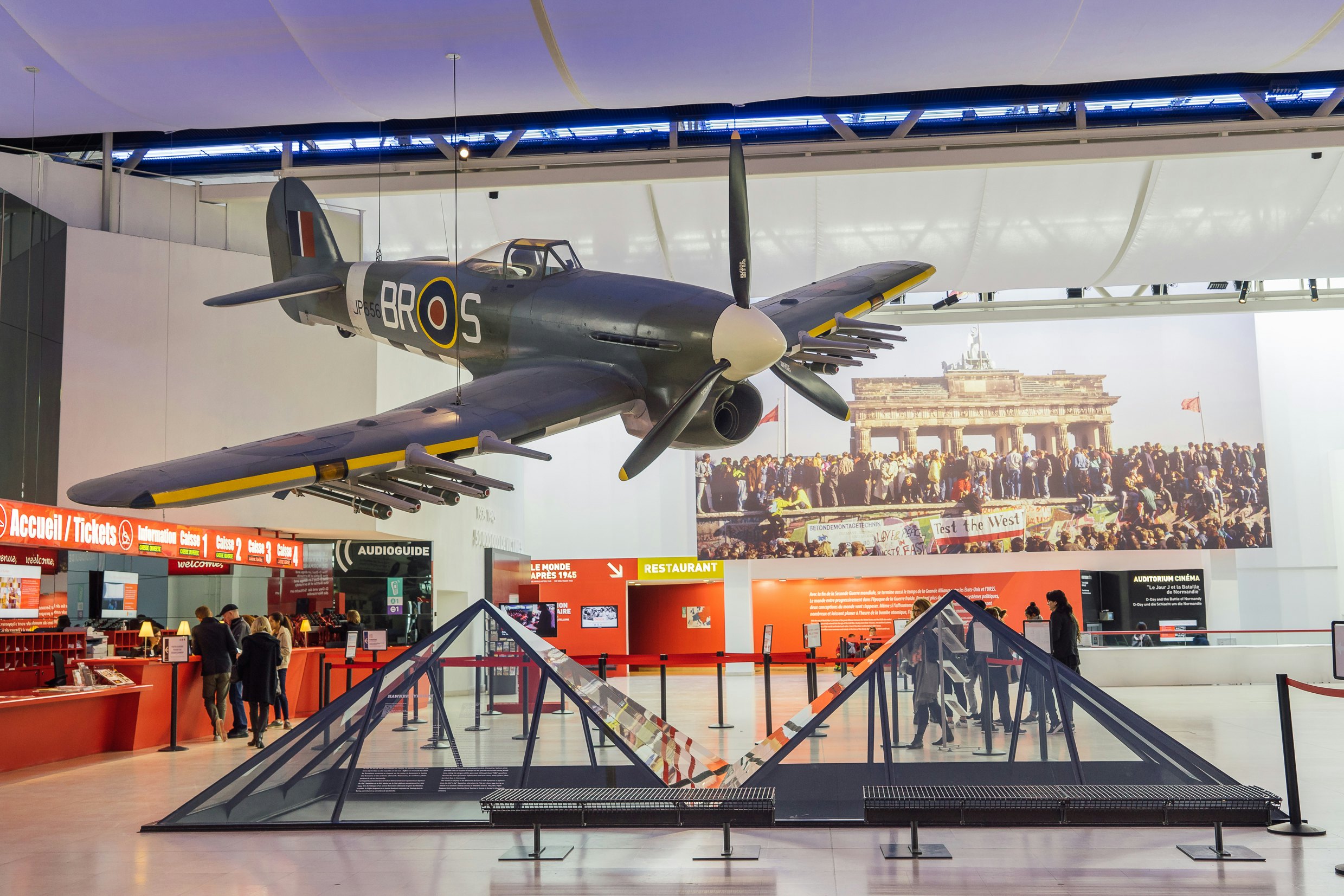
3. Tour Caen Castle and visit the Caen Memorial Museum
Caen is the capital city of the Calvados department of Normandy and has a history going back to Roman times. Today, you can still spot stone houses from the Middle Ages in the Vaugueux neighborhood, and history buffs should check out this unique tour with Viking specialist Laurence. With tours available in both English and French, you’ll visit the castle, town hall, and both the men’s monastery (L’Abbaye-aux-Hommes) and the nunnery (L’Abbaye-aux-Dames).
On rainy days (chances: high, bring an umbrella), you can head inside to the Caen Memorial Museum that sits atop an old German bunker. One of the most visited memorials by the French, this sprawling museum covers an immense amount of ground (plan at least three hours). Despite the breadth of information, there is a uniquely intimate glimpse of the past offered through artifacts: shoes and uniforms that belonged to soldiers, newspapers and propaganda of the day and even a wartime wedding dress made from a parachute.
Once you’ve worked up an appetite, head to Le Bouchon Du Vaugueux for a taste of traditional dishes of the terroir made from locally sourced seasonal products in a snug and convivial space – hone your French-listening skills by eavesdropping on neighboring conversations.
Planning tip: The Memorial Museum, despite a deceptively grand entrance, can get really crowded in the mornings with tour groups. Visit in the afternoon for more breathing room.
4. Sample Camembert on a Normandy cheese tour
In French, there’s a saying “en faire tout un fromage”, which essentially means to make a big fuss, or cheese, out of something. It’s used in a chiding manner, but let’s be real: French cheese is something that deserves a big fuss. Normandy doesn’t lack in the cheese department, and each of the famous four has a hometown you can visit. There’s the world-famous Camembert, which is creamy and soft. Livarot is a soft and stinky cheese made from the local Normandy breed of cows. Pont l’Evêque is a square and soft cheese that reached the height of its fame during the 14th century and offers a subtle hazelnut taste. Finally, there’s Neufchâtel, another soft cheese made from raw milk that also has the honor of being the oldest cheese from the region and usually comes in a heart shape. All are worth a taste, but a visit to the Fromagerie Reo in Lessay merits a visit above the rest. Tour the factory to see firsthand how Camembert is made there with an English-speaking guide and best of all, at the end, you get to sample the cheese.
Detour: If you’ve got enough dairy and have an interest in antique vehicles, head to the nearby Paul’s Classic Cars, where you can look at vintage collection cars like a 1961 Austin Healy and a 1966 Ford Mustang. While there are many Americans obsessed with French cheese, it’s charming to meet one Frenchman obsessed with American cars – most of them are imported from California.

5. Tour the D-Day beaches
About 22km (14 miles) from Bayeux is Omaha Beach, one of the most famous locations of the D-Day landings and home to an impressive Memorial Museum. Nowadays, little evidence of the events of 1944 remains, except for the harrowing American cemetery and concrete German bunkers. At very low tide, you can see remnants of the Mulberry Harbour, a huge temporary port off the coast. Otherwise, it's a tranquil spot, a gorgeous golden stretch with dunes and summer houses. Look out for the yellow stripes marking the Circuit de la Plage d’Omaha, a self-guided tour along the beach.
Detour: Once you’re done, get ready for some of the creamiest and best ice cream of your life at Ferme de la Haizerie in Vaux-sur-Aure. It’s a tiny and unpretentious ice cream shop that offers local flavors such as Calvados, and teurgoule – a Normandy rice pudding – made from fresh farm milk.
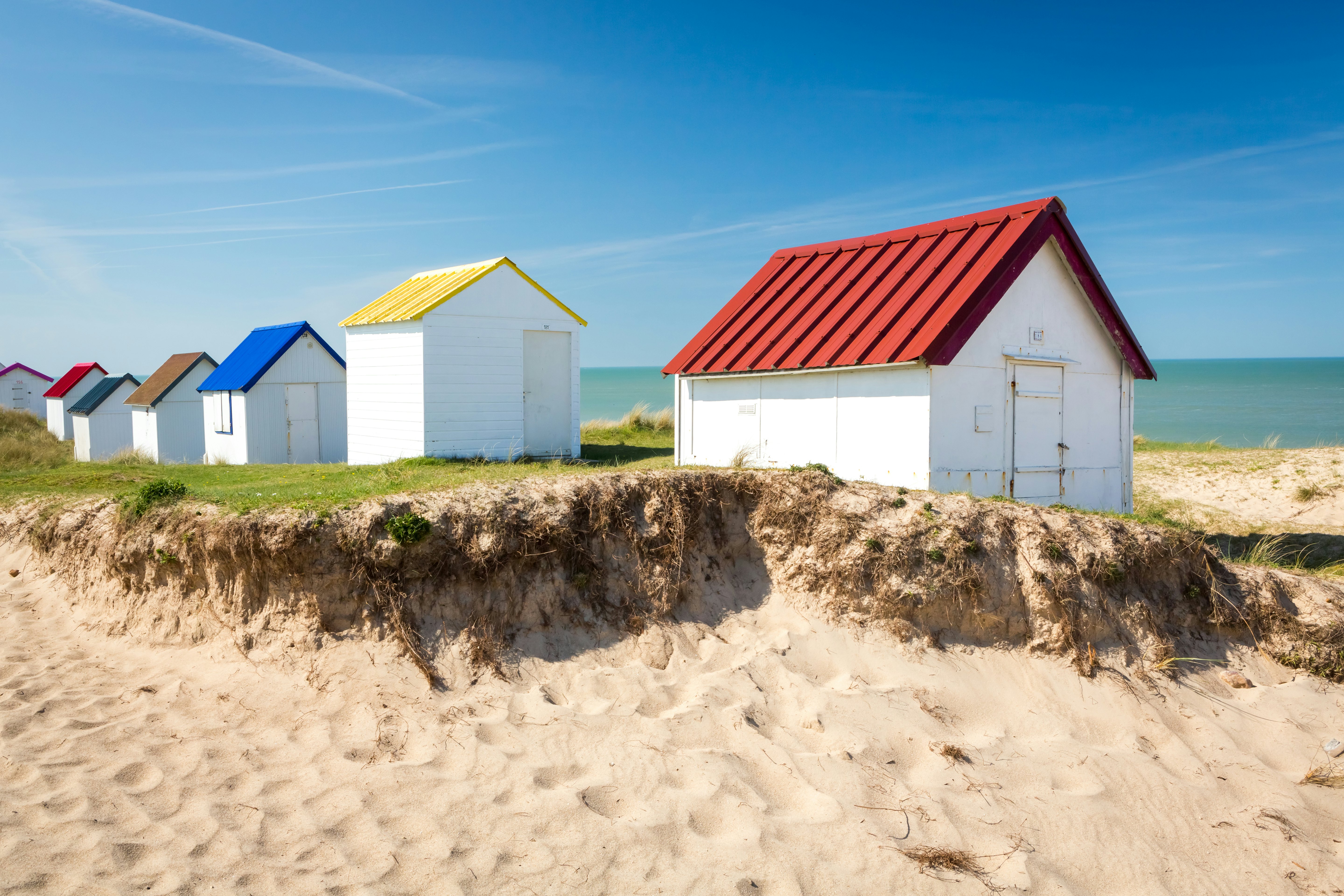
6. Frolic at the colorful beach huts at Gouville-sur-Mer
Sometimes the most beautiful sights are the unexpected and unassuming: impressive Gothic cathedrals are nice, but after a while, all of that grandeur can tire the eye. Take refuge in the pleasing line of white beachside changing cabins with bright primary color roofs in red, yellow and blue that turn the natural landscape of Gouville-sur-Mer into a painting one can meander in. The cabins were originally built for vacationers in the 1920s, disappeared during the German occupation and were reinstated post-liberation – now, there are about 70 in total. Nearby, you can lunch at L’azac, where you’ll find unpretentious and delicious food at affordable prices served by friendly staff.
Detour: Coutances is a 15-minute drive from Gouville-sur-Mer and is home to one of Normandy’s best creperies, Crêperie Le Râtelier, which has been around for over 20 years. Call ahead to reserve a table, because it's often fully booked. Ask for the soubise, a simple crepe of confit onion and butter.
7. Eat oysters fresh off the beach at Barneville-Carteret
For the French, prendre l’air, or to get some fresh air, is a key concept to good health, and there’s no better way to do that than to go for a long stroll on a Normandy beach. Clear your mind in Barneville-Carteret, a town that won’t be teeming with tourists, where you can even find fresh oysters in the water to eat if you can shuck ‘em by hand.
An easier-to-eat fresh and free sea treat are the calyptraea chinensis, also called the Chinese snail hat, which are often found clinging onto the sides of the jagged rocks poking out of the shore. All you need to do is pop them off, and you can eat the flesh immediately for a taste of the Normandy sea. Keep walking north past a row of blue-and-white cabins until you see the ruins of an old church, then look for Le Russel, a cozy and intimate bar à vins with comfort foods like quesadillas and large wedge fries. Wash everything down with a perfectly mulled wine on cooler nights.
Detour: Pick up dessert at La Maison du Biscuit, a charming store that transports you back to 1903. The family-run business offers artisanal cookies, which you can enjoy with a coffee in the tea salon.

8. Sip on Calvados and chug down AOP cider
Apples are abundant in Normandy, and with the plentiful harvest, the locals have turned the fruit into liquid gold. Calvados is a brandy that must be made in Calvados to merit its AOC status (Appellation d’Origine Protégée). Get a taste and tour at Calvados Roger Groult, a family-run distillery that’s been around since the beginning of the 19th century and distilling apples over wood-fires for over five generations. The estate is impressive, and the tour is infused with passion without being overly sales-y – and the tasting at the end works its own magic.
Two hours' drive to the west is Ciderie Claids, a cidery that’s been around since 1992. A visit here is a full-body apple trip; you smell them first, and then the fizzy flavors dance on your tongue. You can even take home a bottle that’s been made in a certain year, just like wine.

9. Visit the charming harbor town of Honfleur
Another Upper Normandy port village to visit with cobblestone streets and houses made of timber, Honfleur oozes with charm. It has been around for over a millennium, but unlike other port cities, it is situated at the end of the Seine, which means it’s at the edge of the sea and riverside. Lining the harbor are tall and narrow slate-roof houses that are reflected in the water, lined with boats by day and glowing with amber streetlights by night.
Meander towards the town hall, where you’ll find a decadent carousel from 1900 that remains frozen in time; lions, giraffes, horses, and old-world glamour carriages spin around and around as the sailboats drift by. From the historic center, it’s a nice uphill hike to the 17th-century chapel (which may be difficult for young children or those with mobility issues), Notre-Dame de Grâce, where you can see model ships, an ancient organ, and views of the sea and the Pont de Normandie.
Detour: From Honfleur, it's a 25-minute bus ride to the neighboring port city of Le Havre. Famous for its artistic inspiration, Le Havre is where the Impressionist painting movement was born, thanks to Monet. Cinephiles may recognize the city as the backdrop to more than 100 films, including the French classic The 400 Blows (1959).
10. Immerse yourself at an interactive manor-turned-museum
Part immersive theater, part history lesson, kids and adults alike will giggle and delight in the poetic and playful adventure-meets-spectacle at Le Manoir du Tourpe. Located in La Hague, this 16th-century manor covers local history, legends, and origin stories through characters that quite literally come to life. Nestled atop a tranquil and lush countryside where the grass stretches for miles, this free museum also offers craft workshops for children, temporary exhibitions, a cafe-hotel-restaurant Auberge des Goubelins, a library, guided hikes, and even a seed and plant library, where you can bring and swap seeds and plant cuttings.
Detour: Lovers of French romanticism can pay homage to the famed poet and screenwriter at Maison Jacques Prévert and daydream of an idyllic, creative existence, about 15km (9 miles) away in Omonville-la-Petite. After a morning of writing under exposed wooden beams, take a leisurely walk along stone-paved paths through a garden perfumed with orange tulips, daisies and lilies until you reach an old church and cemetery to ponder the ephemeral nature of life.
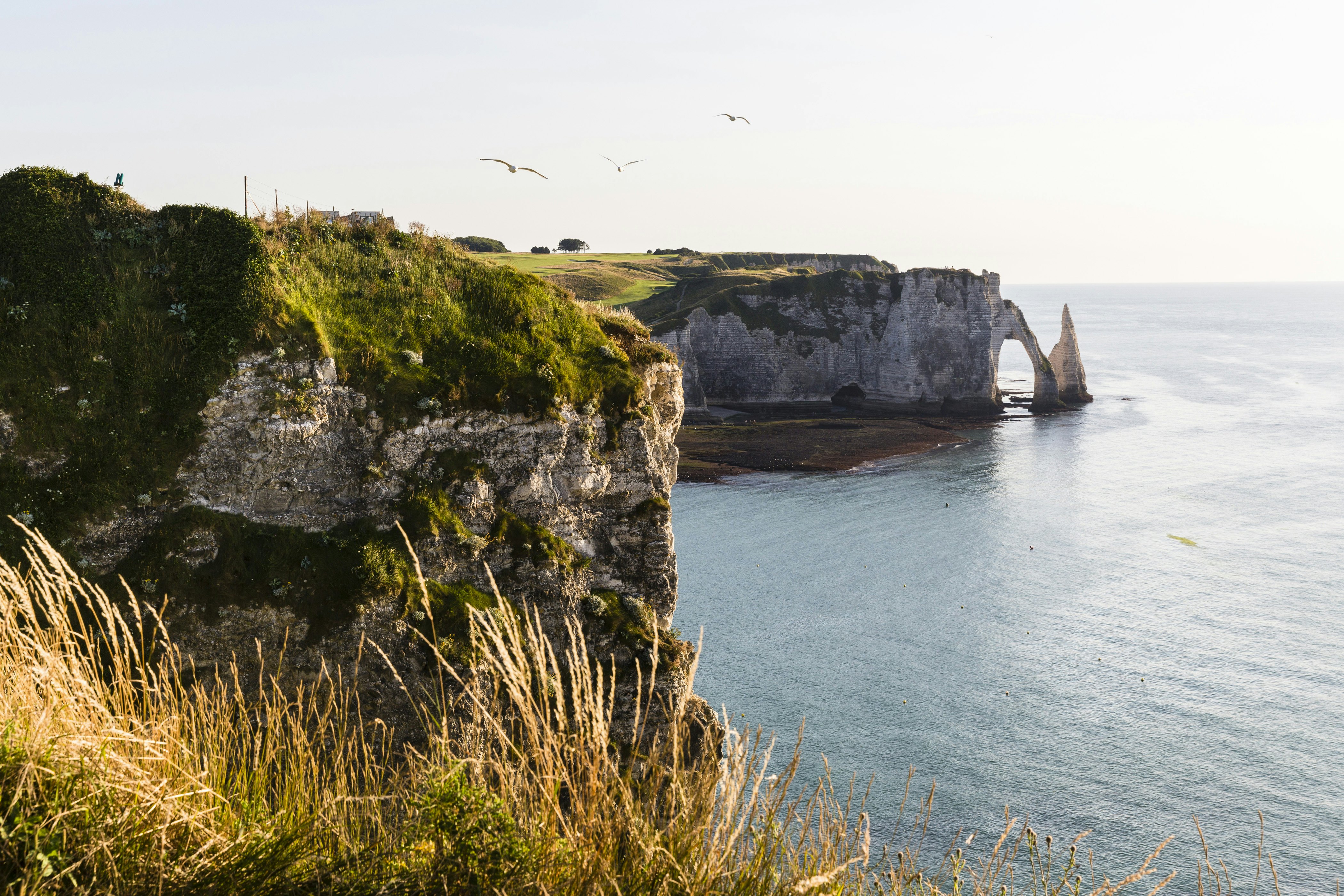
11. Walk the rocky cliffs at Étretat
For a contact high with nature, head straight to the falaises of Étretat to enjoy the staggering sights of the dizzying chalk cliffs, made up of a type of porous limestone that inspired the likes of painters Claude Monet and Gustave Courbet. Due to the fragile nature of the stone, walking underneath is not allowed, but there are numerous hikes in the area for those who want to take in the natural splendor of the rocky arches. The well-paved hike of Porte d'Amont Loop that begins at Chemin de Criquetotis is suitable for any fitness level and takes about an hour (though allow longer to really soak in the mythic scenery). For more hardcore hikers, the Roc Vaudieu loop, which takes about four to five hours, offers incredible views of the massive cliffs that emerge from the water.
Detour: Aspiring writers may want to visit La Guillette, a villa built by short story writer Guy de Maupassant after he achieved publishing success. You can see the house where Maupassant worked on Bel Ami and Pierre et Jean, but for actual visits inside, contact the association via this form.
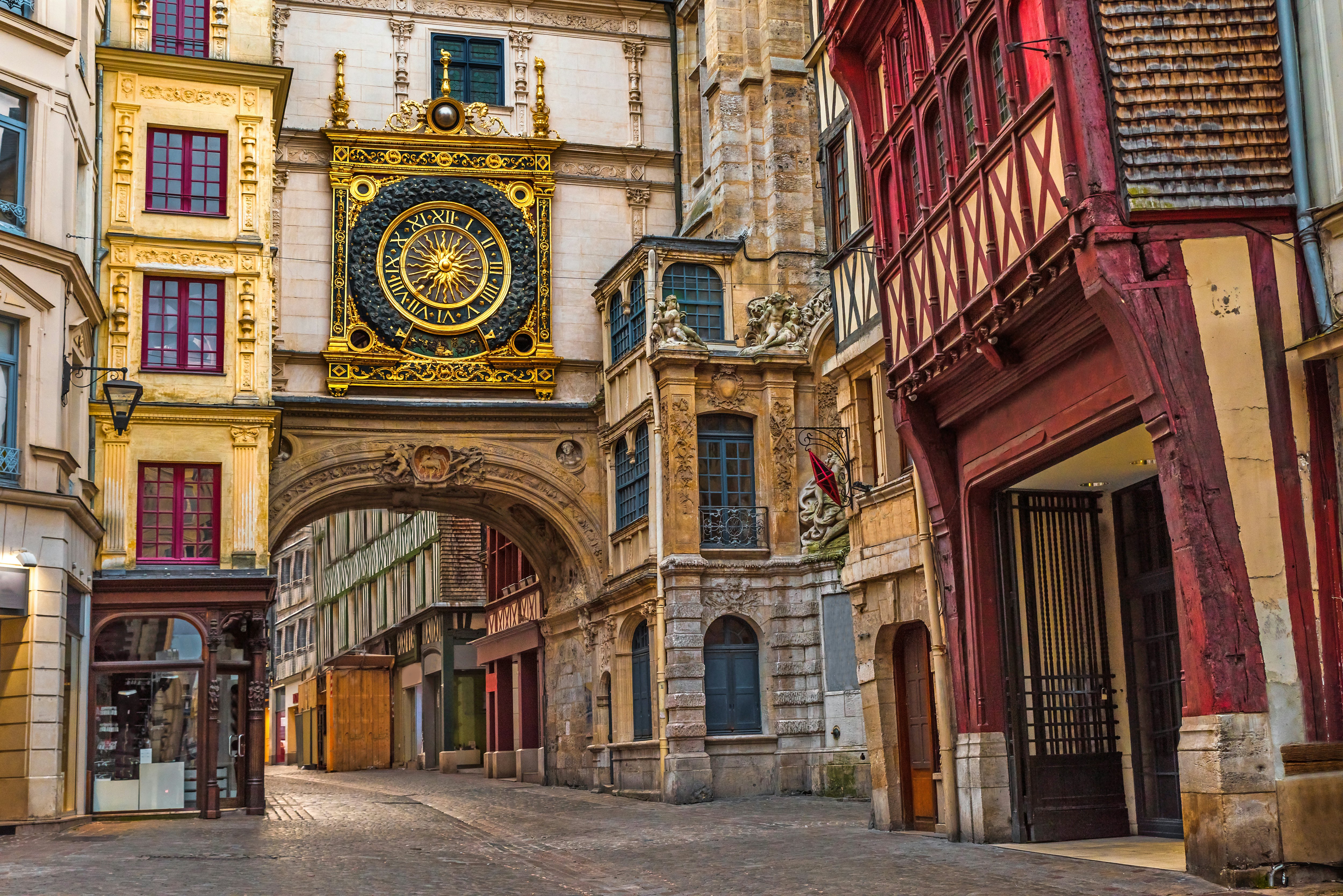
12. Spend a day in Rouen, Normandy’s capital city
Like other charming port cities of Normandy, Rouen has endured since Roman times and is brimming with medieval architectural charm. Art aficionados will particularly appreciate the Musée des Beaux-Arts, which offers a range of idyllic landscape paintings, homages to ecclesiastical greatness and, of course, Impressionist masterpieces. Best of all: admission is free. If contemporary art is more your speed, Rouen is also known for its street art – follow the map for a glimpse of urban and contemporary art in an ancient city.
Next, be awed as you stand underneath the 14th-century astronomical clock in the city center as the bells ring. A guide is available to explain the intricate detailing of the clock, for a fee.
13. Snag a striped sweater at Saint James
Clichés of French style include a beret paired with a horizontally striped sweater (cigarette and baguette accessories depending on the time of day), and one of the classic brands for French knitwear, Saint James, is also a charming little village you can visit. The most famous export, the striped shirt, has a long history: they were uniforms for the navy seamen of the North, and the original 1858 design has 21 stripes for each of Napoleon Bonaparte’s victories in war. For a firsthand look at how the sweaters are made, you can get a tour of the Saint James atelier and then leave the shop with your own Breton striped sweater or shirt.

14. See the famous 11th-century tapestry in Bayeux
Before there was Netflix, there was the Bayeux Tapestry, an 11th-century 70m-long (230ft) scroll of hand-embroidered wool thread on linen that tells the story of the Norman Conquest of England. And incredibly, this rare piece of art is just as mesmerizing as it ever was. At the museum, you enter a dark and cool chamber wrapped with tales of 1066: warfare, kings being crowned, kidnappings, farming, and even a comet. This one-of-a-kind piece radiates with a strange magic; since it was commissioned shortly after William the Conqueror’s victory at the Battle of Hastings, it’s as if the emotions of the time were captured through thread and needle by those who lived and witnessed the events.
It's important to note that the Bayeux Tapestry will undergo a two-year restoration starting on August 31, 2025, and will not be visible to the public during that period.












